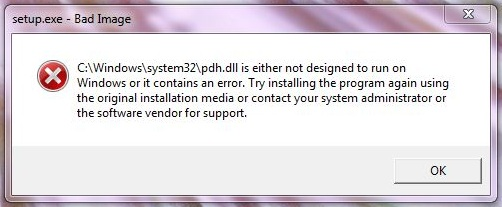What is “Bad Image” pop-up error
“Bad Image” pop-up error is a fake pop-up message that appears when you start the computer or program. As was stated earlier, it is not system error and cause of it is the presence of malware on your computer. It certainly gets on your nerves because any attempt to run the program will be failed. And instead of this, the pop-up error is displayed. “Bad Image” pop-up error is often a part of Trojan infection, so it has a same methods of distribution. For instance, it can pretend to be the update for some legitimate software like fake update for Adobe Flash Player. Thus, while you think that you are updating some program you are actually installing malicious infection. You can infect the system by downloading illegitimate software from torrents or some cracks for games or programs. Hackers also use vulnerabilities on your computer to spread virus through exploit kits when browsing websites.

How to fix “Bad Image” pop-up error
Easiest way to fix “Bad Image” pop-up error is to use special computer optimizer Advanced System Repair. It will scan your computer for system errors and issues. Advanced System Repair has a wide range of solutions to most of the system problems, including “Bad Image” error. Install it and run the scan, then watch it fixing your system’s issues.
In order to fix “Bad Image” pop-up error manually, you should perform following steps:
How to remove Funnysearching.com manually
Step 1: Remove “Bad Image” pop-up error from Control Panel
In order to get rid of “Bad Image” pop-up error, first thing you need to do is to uninstall malicious program from your computer. When removing “Bad Image” pop-up error, try to find suspicious recently installed programs and delete them, as it’s always a part of other program.
Windows XP:
- Select Start.
- Control Panel.
- Then choose Add or Remove Programs.
- Search for the program related to “Bad Image” pop-up error.
- Click Uninstall.
Windows 7/Windows Vista:
- Select Start.
- Then Control Panel.
- Choose Uninstall a Program.
- Find the program related to “Bad Image” pop-up error and choose Uninstall.
Windows 8/Windows 8.1:
- Open the Menu.
- Select Search.
- After that choose Apps.
- Next Control Panel.
- Then as in Windows 7, click Uninstall a Program under Programs.
- Find the program related to “Bad Image” pop-up error, select it and choose Uninstall.
Windows 10:
- Click on the Start button (or press the Windows key) to open the Start menu, then select Settings at the top.
- Choose App & features on the left menu.
- On the right side, find the program related to “Bad Image” pop-up error and select it, then click on the Uninstall button.
- Click on Uninstall to confirm.
Note: If you can’t find required program, sort programs by date in Control panel and search for suspicious recently installed programs.
Step 2: Remove “Bad Image” pop-up error from browsers
Once you’ve uninstalled the application, remove “Bad Image” pop-up error from your web browser. You need to search for recently-installed suspicious add-ons and extensions.
Google Chrome:
- Open Google Chrome
- Push Alt + F.
- Choose Tools.
- Select Extensions.
- Search for the program related to “Bad Image” pop-up error.
- Select the trash can icon to remove it.
Mozilla Firefox:
- Open Firefox.
- Push Shift + Ctrl + A.
- Select the program related to “Bad Image” pop-up error.
- Choose Disable or Remove option.
Internet Explorer:
- Open IE.
- Push Alt + T.
- Choose Manage Add-ons option.
- Click Toolbars and Extensions.
- Next select Disablethe program related to “Bad Image” pop-up error.
- Choose More information link in the left-bottom corner.
- Click Remove button.
- If this button is grayed out – perform alternative steps.
Step 4: Resetting your browser search and homepage settings
To be sure that there is nothing left behind, we recommend you to reset your browser. It will restore your browser settings to default.
Reset browser settings in Google Chrome:
- Click the Chrome menu (3 bar button) in the top right corner.
- Choose Settings.
- Click Show advanced settings.
- Go to Reset browser settings section.
- Click Reset browser settings.
- In the dialog that appears, click Reset.
Reset browser settings in Mozilla Firefox:
- Open Mozilla Firefox.
- Go to Help.
- Go to Troubleshooting information.
- Click Reset Firefox… button.
Reset browser settings in Internet Explorer:
- Open Internet Explorer.
- Click on the cogwheel in the right upper corner.
- Click Internet options.
- Got to Advanced tab.
- Click Reset button.
- Put a tick near Delete personal settings checkbox.
- Click Reset button.

